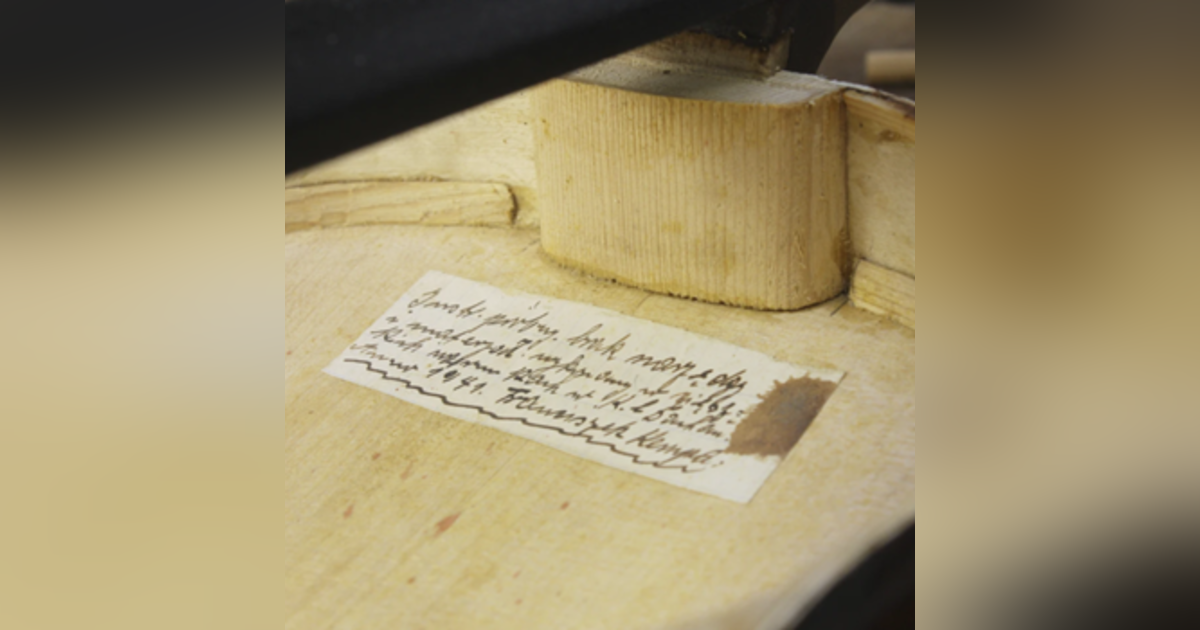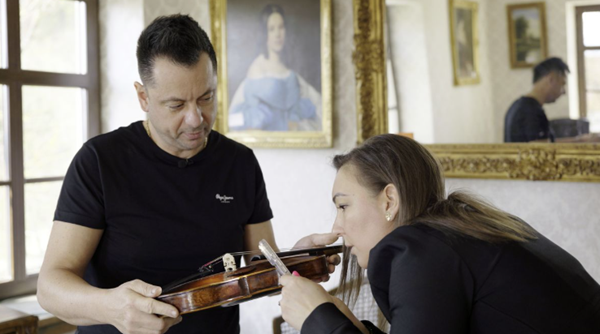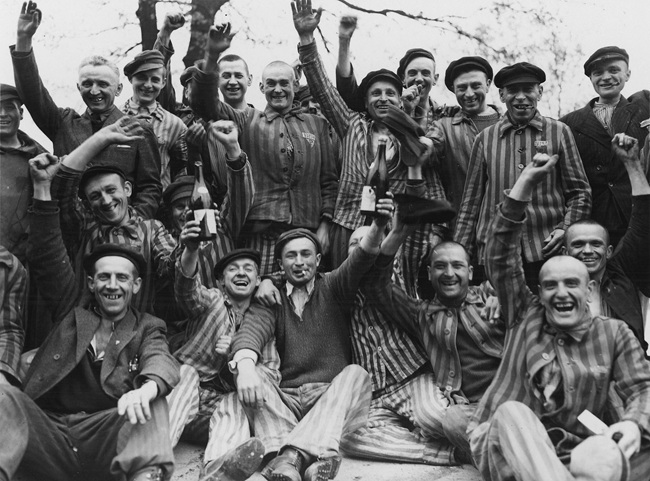A Prisoner, Limited Tools, A Violin of Hope

This is the story of a very old violin that stored a secret—one that lay hidden for 80 years. This instrument was crafted behind barbed wire in the Dachau prison camp, by a prisoner fighting to survive.
Supporting links
1. Franciszek Kempa [Wikipedia]
2. Dachau concentration camp [Wikipedia]
3. Violin Crafted in the Infamous Dachau Death Camp [Yeshiva World News]
4. How a Violin is Made [Simply for Strings]
5. Violin making process explained (Documentary with Commentary) [YouTube]
Contact That's Life, I Swear
- Visit my website: https://www.thatslifeiswear.com
- Twitter at @RedPhantom
- Bluesky at @rickbarron.bsky.social
- Email us at https://www.thatslifeiswear.com/contact/
Episode Review
- Submit on Apple Podcast
- Submit on That's Life, I Swear website
Other topics?
- Do you have topics of interest you'd like to hear for future podcasts? Please email us
Interviews
- Contact me here https://www.thatslifeiswear.com/contact/, if you wish to be a guest for a interview on a topic of interest
Listen to podcast audios
- Apple https://apple.co/3MAFxhb
- Spotify https://spoti.fi/3xCzww4
- My Website: https://bit.ly/39CE9MB
Other
- Music ...
⏱️ 15 min read
This is the story of a very old violin that stored a secret—one that lay hidden for 80 years. This instrument was crafted behind barbed wire in Dachau, a concentration camp, by a prisoner fighting to survive. Now understand this is not just any instrument. Rather it’s a message, a miracle, and a memory carved into wood.”
This is the extraordinary story of the ‘Violin of Hope’—the only known instrument built inside a Nazi concentration camp, and the man whose hands gave it life.”
Adding to this remarkable narrative was what was found inside this old violin. What was it? You’re about to find out
Welcome to That's Life, I Swear. This podcast is about life's happenings in this world that conjure up such words as intriguing, frightening, life-changing, inspiring, and more. I'm Rick Barron your host.
That said, here's the rest of this story
The Violin of Hope: Franciszek Kempa's Defiant Act of Creation
There have been many dark moments in human history. Where suffering seems boundless and hope appears extinguished, small acts of creation can become profound statements of resistance. Such is the story of a violin crafted in 1941 within the confines of Dachau concentration camp. It was an instrument that would remain silent about its origins for over eight decades before finally revealing its extraordinary tale. The revealing secret was a simple note.
The note read as follows: "Trial instrument, made under difficult conditions with no tools and materials. Dachau. Anno 1941, Franciszek Kempa."
The words were written on a small piece of paper, now worn and secretly stored within a violin's hollow body. The note connects us directly to a moment of remarkable human resilience. They form a bridge across time—from the brutal reality of Nazi concentration camps to our present day.
The note reads almost like an apology from a master craftsman, explaining why his work fell short of the standards to which he had dedicated his life. Yet in this humble explanation lies an extraordinary testament to the human spirit.
Tamas Talosi and Szandra Katona inspect the rare violin. Courtesy of: The Japan News
When Hungarian art dealers, Tamas Talosi and Szandra Katona, sent the violin for repair after discovering it among purchased furniture, they could not have anticipated the historical treasure they possessed. Initially puzzled by the contradiction between evident craftsmanship and poor materials, the repairer disassembled the instrument to find Kempa's hidden message. This revelation transformed a curious antique into a powerful historical artifact and symbol of hope.
The Maker Behind the Violin
Franciszek "Franz" Kempa was more than just a prisoner at Dachau; he was a master violin maker whose identity and professional pride persisted despite the Nazi regime's systematic efforts to strip prisoners of their humanity. The documents recovered from the Dachau memorial site suggest that Kempa's skills as an instrument maker were known to his captors—knowledge that may have contributed to his survival when millions of others perished.
Franciszek "Franz" Kempa. Courtesy of: The Winnipeg's Classic 107
Born in Poland, Kempa had likely spent years mastering his craft before the war, developing the precision and artistry that would later be evident even in an instrument created under the most dire of circumstances. His expertise was so ingrained that even without proper tools or materials, his trained hands could produce something recognizable as the work of a master.
After surviving the horrors of Dachau, Kempa returned to his native Poland, where he continued making instruments until his death in 1953. This detail is poignant—a testament to how deeply intertwined his identity was with his craft. Even after experiencing unimaginable trauma, he returned to the work that had perhaps helped preserve not only his life but also his sense of self during captivity.
Dachau: A Workshop of Horror
To understand the true significance of Kempa's violin, one must comprehend its created environment. Dachau, established in March 1933 near Munich, was the first concentration camp opened by the Nazi regime. Initially designed to hold political prisoners, it evolved into a model for other camps and eventually imprisoned Jews, clergy, homosexuals, and others targeted by Nazi persecution.
The camp became synonymous with forced labor, medical experimentation, and systematic brutality. By the time American forces liberated Dachau on April 29, 1945, at least 40,000 people had died there from starvation, disease, execution, or mistreatment. This was the reality in which Kempa somehow managed to create his violin—where basic human needs like adequate food, shelter, and dignity were denied, let alone specialized materials for crafting musical instruments.
While musical instruments were present in many concentration camps—often permitted by the Nazis for propaganda purposes to present a false image of camp life—all previously known instruments at Dachau were believed to have been brought in by prisoners. Kempa's violin stands unique as the only known instrument constructed within the camp's walls, making it not just a historical curiosity but a singular artifact of creative resistance.
Creating Amid Destruction
The contradiction inherent in Kempa's violin is profound. While the Nazis operated a system designed to destroy, Kempa engaged in an act of creation. Using whatever materials, he could collect and improvising tools from available objects, he transformed raw components into something that could produce beauty. The very act of crafting the violin—regardless of its quality relative to his pre-war work—was a defiance of the destructive environment surrounding him.
This creative act likely provided Kempa with more than just a way to pass the time or demonstrate his skills to the Nazis. Creating something beautiful amid ugliness, something ordered amid chaos, offered psychological sustenance that may have been as crucial to his survival as any physical nourishment. By focusing intensely on a task that connected him to his pre-war identity, Kempa could temporarily escape the harsh realities of the camp, preserving a core sense of self when the system was designed to eradicate individuality.
In the words of Hungarian art dealer Tamás Tálosi, who helped uncover the violin's history, she said and I quote: "We named it the 'violin of hope' because if someone ends up in a difficult situation, having a task or a challenge helps them get through a lot of things. You focus not on the problem but on the task itself, and I think this helped the maker of this instrument to survive the concentration camp." End quote
The Journey of an Instrument
The path the violin took from Dachau to a Hungarian art dealer's collection remains unknown—a mystery that mirrors countless objects displaced during the chaos of World War II and its aftermath. Did Kempa give it to a fellow prisoner? Did a guard take it? Did he carry it with him upon liberation? These questions remain unanswered, yet the instrument's survival through decades of obscurity feels almost miraculous.
We know that the violin carried its secret message for over 80 years before revealing its origins. During that time, it existed as an ordinary, if curious, instrument—played, displayed, stored, sold, and eventually put aside among furniture. It harbored a direct connection to one of history's darkest chapters, waiting for the moment when its true significance would be discovered.
The violin's journey from creation to discovery parallels how history often works—important stories remain hidden, sometimes for generations, before emerging to shed new light on our understanding of the past. Kempa's message, preserved within the instrument's wooden body, traveled through time like a message in a bottle, eventually reaching a world ready to hear its story.
Art as Survival Strategy
Kempa's violin joins a broader legacy of art created under extreme duress during the Holocaust. From poetry written on scraps of paper in ghettos to sketches made by camp prisoners documenting their experiences, creative expression became a crucial survival strategy for many. These works serve multiple purposes: they help preserve sanity, maintain cultural identity, document atrocities, and sometimes even improve one's standing with the prison guards.
Kempa's violin is remarkable because it combines practical skill with artistic expression. Unlike a poem or drawing that might be hidden away, a violin is an object meant to be seen and heard. Its creation required artistic vision, technical knowledge, manual dexterity, and problem-solving abilities—all sustained under conditions specifically designed to break the human spirit.
U.S. forces liberated the Dachau concentration camp on April 29, 1945. Courtesy of: Wikipedia
The violin shows that people found ways to express themselves even in places designed to eliminate human dignity and creativity. In creating this instrument, Kempa asserted his humanity in a system that sought to deny it. Each careful cut, each improvised joint, and each decision about form represented a small rebellion against the dehumanizing process of the camp.
The Music That Never Was
One of the most poignant aspects of Kempa's violin is whether it ever produced music within Dachau. Did its strings ever vibrate within the camp? Did Kempa or another prisoner ever play it, creating moments of beauty amid horror? The historical record offers no answers, leaving us to contemplate this haunting possibility.
If the violin were played in Dachau, its music would have represented another layer of resistance—sound waves temporarily transforming the atmosphere of oppression. Music in concentration camps was a complex phenomenon, sometimes forced as part of Nazi propaganda, sometimes secretly shared among prisoners as comfort or communion. Whatever notes may have emerged from Kempa's violin would have carried meanings beyond the melodies themselves.
Even if the instrument remained unplayed until after the war, it represented potential music—a promise of sounds that could exist once freedom was restored. In this sense, the unplayed violin might be seen as an expression of hope for a future where beauty could again flourish without constraint.
A Physical Relic of Moral Victory
Today, Kempa's violin serves as a tangible connection to an individual story amid statistics of mass suffering. While we necessarily speak of Holocaust victims in overwhelming numbers—six million Jews, millions of others—this single instrument reminds us that each number represents a person with skills, hopes, and an inner life that persisted despite systematic efforts to extinguish it.
The violin embodies what philosopher Viktor Frankl, himself a Holocaust survivor, described in his seminal work "Man's Search for Meaning": the irreducible freedom to choose one's attitude even when all other freedoms have been taken away. Despite being deprived of proper materials, tools, and basic human dignity, Kempa chose to create rather than merely survive.
In this light, the violin represents not just physical survival but a form of moral victory. Even as the Nazi regime inflicted its worst, Kempa maintained his identity as a craftsman and his connection to beauty and creation. His note, explaining the instrument's shortcomings, shows he maintained professional standards and pride in his work even when circumstances made meeting those standards impossible.
The Resonance of Hope
The name given to Kempa's creation—"the violin of hope"—captures its enduring significance. More than just a historical artifact, it is a powerful metaphor for human resilience. Like hope itself, the violin survived against overwhelming odds, carried its message through decades of obscurity, and eventually emerged to inspire others.
Its discovery in our time provides an opportunity for reflection on how creative acts can sustain us during our periods of difficulty. While few will face circumstances as extreme as Kempa's, his example reminds us that focusing on creation rather than despair offers a path forward, even in dark times.
The violin also challenges us to consider what we might create under difficult circumstances—not just physical objects but moments of kindness, expressions of truth, or works of beauty that defy the limitations around us. It asks us to recognize the profound statement made when one chooses to create rather than destroy, to build rather than break.
Conclusion: The Enduring Echo
The story of Franciszek Kempa's violin continues to resonate, quite literally, as it has been restored and can now produce the music its maker intended. Each note played on this instrument carries with it the echo of its extraordinary origins—a concentration camp where death was commonplace but where one man insisted on creating life through his craft.
In the end, Kempa's hidden note was more than an explanation for the violin's technical shortcomings; it was a message to the future that creative resistance is possible even in humanity's darkest hours. Eight decades later, that message has now been received by a world that continues to need reminders of hope's persistence.
The violin proves that even when surrounded by mankind's most incredible cruelty, the human capacity for creation cannot be fully extinguished. In this simple wooden instrument, we find an extraordinary testament to the resilience of the human spirit and a reminder that even in our darkest hours, we retain the power to create rather than merely endure.
What can we learn from this story? What's the takeaway?
Franciszek Kempa’s violin is a reminder that even in the face of crushing inhumanity, the human spirit has ways of enduring. It can find expression in art, even under the weight of genocide. It can carve meaning from scraps of wood and string. It can speak, even from silence, across eight decades of forgetting.
The "Violin of Hope" is more than an instrument. It is an answer to brutality with beauty. It is a statement that even within a system designed to erase identity, one man found a way to leave his mark—not in rage or rebellion, but in craft, in care, and in courage.
As we listen to its story today, may we not only remember Kempa’s bravery but also reflect on what it means to create, endure, and hope.
Well, there you go, my friends; that's life, I swear
For further information regarding the material covered in this episode, I invite you to visit my website, which you can find on Apple Podcasts for show notes and the episode transcript.
As always, I thank you for the privilege of you listening and your interest.
Be sure to subscribe here or wherever you get your podcast so you don't miss an episode.
And we’ll see you soon.













